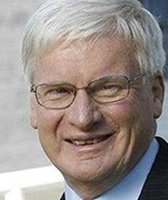Get PolitiFact in your inbox.

Milwaukee Police Chief Ed Flynn and Milwaukee County Sheriff David A. Clarke Jr.
Depending on which top cop you listen to, Milwaukee’s homicide rate is either:
-- Lowest among "comparable cities" in America. That’s Milwaukee Police Chief Edward Flynn’s view.
-- "Fourth-highest in the nation." That’s the world according to Milwaukee County Sheriff David A. Clarke Jr.
The two men have been increasingly at odds.
When the sheriff advised citizens to take up arms because dialing 911 is "no longer your best option," Flynn said Clarke was undermining confidence in police and "terrorizing" residents. Clarke, in turn, blasted Flynn’s aggressive call before a congressional committee for a new assault weapons ban -- going so far as to issue an apology for Flynn’s tone.
Here we’re examining a Flynn-Clarke statistical spat that reveals not only some hard truths about Milwaukee but how poorly packaged numbers or dubious data collection can mislead or oversimplify.
The Flynn view
In 2012, Milwaukee had 92 homicides, an increase of 6 percent from 2011. The rise came amid a jump in violent crime, driven largely by an increase in aggravated assaults.
Flynn reported the increase when he briefed aldermen on March 7, 2013. But he sought to reframe how the public perceives it.
"We've got too much violence in Milwaukee," Flynn said. "But if we are compared to cities with similar challenges, we are in a better place than one might expect."
Flynn then presented a table of statistics showing homicide data for what were described as 10 "comparable" cities -- Detroit, Baltimore, Baton Rouge, Newark, Cleveland, Memphis, Philadelphia, Atlanta and Cincinnati.
Milwaukee came out best.
Flynn told aldermen the main factor in common among the cities was high poverty. By all accounts, Milwaukee is a top-10 poverty city.
But the list was puzzling.
It included a very small sample and a wide range of populations (230,000 to 1.5 million). It included some of the very highest-poverty cities as ranked by the U.S. Census bureau, but not others. In the case of four of the cities, the poverty rate shown was wrong -- and by a wide margin.
What’s more, Flynn used outdated poverty figures for most of the cities, ranging from 23.8 percent to 37.6 percent. He listed 10 cities, but that range roughly matches up to the top 20 poverty cities.
When we did a simple search of media and police websites on the top 20, we found six cities over 250,000 in population with better homicide rates than Milwaukee -- Fresno, Dallas, Toledo, St. Paul, Tucson and Houston. We used 2011 poverty rankings.
So, Milwaukee does stack up better than many, but not best.
How did this come together?
When we asked Flynn about the methods, he labeled it a "convenience sample." That’s an actual method used by researchers as an easy alternative to more sophisticated sampling. But it comes with many warnings about the risk of bias and misleading conclusions.
Flynn told us he wanted the poverty data to put the homicide rate in context when he released Milwaukee’s total for 2012, because criminologists have correlated crime and poverty. The comparison was mentioned in the Jan. 17, 2013 news release.
His staff consulted a Detroit News "Murder Cities" graphic based on a list of top 2012 homicide rates compiled by reporters.
Then Flynn’s staff started calling departments on the top-20 Census list of high-poverty cities. When homicide data for a particular city was not yet available, Flynn said his staff simply left it off the list.
Flynn acknowledged he could have updated and expanded the chart for his March 7, 2013 appearance before aldermen, but said he wanted to avoid accusations he had altered the numbers.
Flynn told us he was trying to illustrate the poverty point, not polish up the homicide increase.
But he added: "This can be tweaked so many ways to make us look better or worse. It depends on what you have available to you, what your standard is."
Indeed, if Flynn and company had waited for more complete data, and just went with the top 10 poverty cities, they still could have reported a positive result -- just not as stark as what the chief presented.
Using the latest available 2011 rankings, Milwaukee would have been third-lowest in the top 10.
That's a muddier result.
For an outside opinion on the "convenience sample" approach, we turned to Villanova University sociologist Lance Hannon. The veteran researcher on crime and poverty credited Flynn for linking the two but was critical of the technique used.
"I think its fairly obvious that the ‘convenience sample’ here is convenient for the purposes of the person who put it together," Hannon said.
In addition, the limited and dissimilar mix of cities and use of different comparison years for poverty and homicide are problematic, Hannon said.
What’s more, he added that the choice of homicide was "the absolute wrong crime to do this with" because there are relatively few homicides and one violent episode can cause major year-to-year variations.
The Clarke view
In an op-ed piece on Right Wisconsin, Clarke called Flynn’s poverty-homicide link a "made up" one and "an insult to the economically poor." Right Wisconsin is a conservative political site led by radio host Charlie Sykes at WTMJ. The station, like the Journal Sentinel, is part of Journal Communications.
Clarke mocked the poverty yardstick, saying that maybe Flynn "didn’t like the numbers he saw for his first choices: Cities with Smallest Average Yard Sizes or Cities with Lowest February Temperatures."
"The truth is that Milwaukee’s homicide rate per 100,000 people is fourth highest in the nation," wrote Clarke. Down in the piece, Clarke clarified that he meant among cities of 500,000 to 999,999 for 2010, but the resulting headline was, "Milwaukee Has 4th Highest Murder Rate in the Nation."
At 597,000, Milwaukee’s population is near the bottom of that range. As with Flynn’s approach, it was an effort to find a comparison point that, well, made a particular point.
We checked crime stats compiled by the FBI and found Milwaukee had the fifth-highest rate in that group in 2010 -- fourth if you exclude Washington, D.C. For 2011 (the latest available) the ranking was the same.
Even if you include cities down to 250,000 and up to the largest city, New York, Milwaukee’s 2011 rate was on the high side -- 18th out of 73 places.
Responding to Clarke’s piece, Flynn call the statistic "simplistic."
"It makes no sense to compare us to Seattle, or San Jose, or any city that may be about our size," Flynn told us. "Seattle has half our poverty rate and yet they are almost the same size we are. It’s an irrelevant comparison."
For his part, Clarke stood by his use of the numbers, but said: "I’m not saying there’s significance to what the FBI does" in making the figures public.
Say what?
Clarke, Flynn and Villanova’s Hannon are all well aware of the very prominent disclaimer the FBI places on its online crime stats website.
"These rough rankings provide no insight into the numerous variables that mold crime..." the FBI site says. "Consequently, they lead to simplistic and/or incomplete analyses that often create misleading perceptions adversely affecting communities and their residents. The data user is, therefore, cautioned against comparing statistical data of individual reporting units … solely on the basis of their population coverage or student enrollment."
The FBI lists various factors related to the "causes and origins" of crime in different communities.
Poverty is one, as well as population density, high concentrations of youth, and factors related to mobility, transportation systems, cultural norms, family conditions, climate, relative strength of police agencies, policing priorities, and citizen attitudes.
No matter the causes, Flynn and Clarke agree violence is still too common in Milwaukee.
Flynn points to progress. During his tenure homicides have fallen 20 percent compared to the five years before his 2007 arrival.
Clarke’s not impressed:
"We’re at the top of the worst," he said. "That’s nothing to crow about."
Our Sources
Right Wisconsin, op-ed by Sheriff David A. Clarke Jr., March 11, 2013
Milwaukee Journal Sentinel,"Edward Flynn: Milwaukee has the lowest homicide rate of 10 cities with heavy poverty," March 7, 2013
US Census Bureau, "Poverty Rates for Places of 250,000 and More: 2010-11," created March 11, 2013
Interview with Police Chief Edward Flynn, Deputy Inspector William Jessup, Deputy Inspector Mary Hoerig, Chief of Staff Joel Plant, Public Information Officer Mark Stanmeyer, crime analyst Brian Baldwin, crime analyst Dan Polans, March 14, 2013
Interview with Sheriff David A. Clarke Jr., March 14, 2013
Interview with Lance Hannon, associate professor of sociology, Villanova University, March 14, 2013
Email exchange with Fran McLaughlin, public information officer, Milwaukee County Sheriff’s Department, March 13-14, 2013
Interview with Suzanne Macartney, poverty statistics branch, U.S. Census Bureau
Interview with Andrew Karmen, sociology professor, John Jay College of Criminal Justice, March 13, 2013
Milwaukee Police Department, presentation to Public Safety Committee, 2012 crime, (Part 1 offenses on page 2, Homicide in Comparable Cities on page 6), March 7, 2012
FBI, "Caution Against Ranking," accessed March 14, 2013
Milwaukee homicide-poverty rate chart, assembled by Milwaukee Police Department, published in Milwaukee Journal Sentinel, March 8, 2013

















































